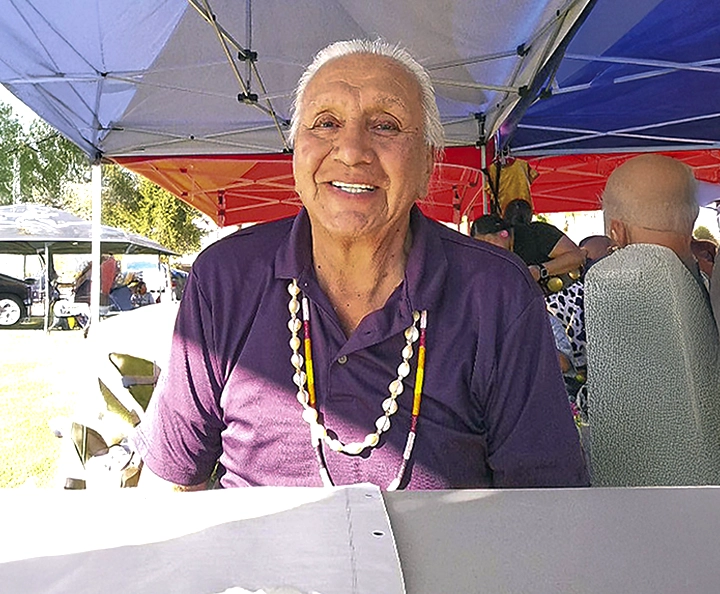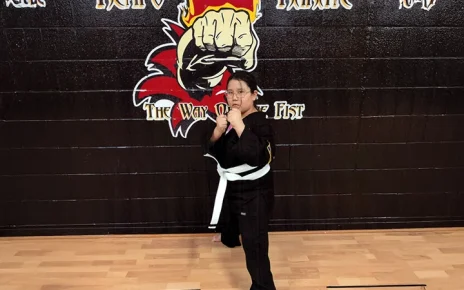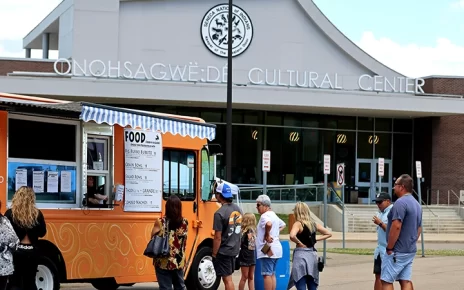Dennis Bowen Sr. Retiring after 50 Years on the Powwow Trail
April 24, 2025 | By Marshall Baker | Reprinted from Navajo Times
PHOENIX – With the world-renowned Gathering of Nations Powwow in Albuquerque coming up this weekend, this year’s festivities will be without its longtime voice and master of ceremonies, Dennis Bowen Sr.
With a tenure that spans over 30 years with the Gathering of Nations, Bowen is one of the most recognizable voices in Indian Country not only as a powwow emcee but as a community leader and cultural educator. Now retiring as a member of the head staff, Bowen reflects on his time spent speaking for the powwow and many more across the country; as well as the journey that led him there.
“It kind of sounds like say-ing, I’m not going to announce. here anymore, And that’s not the feeling that I have,” Bowen said.
Trailblazer on the powwow circuit
Bowen hails from the Seneca Nation from the Allegany Seneca Territory in western New York and is Bear Clan. Bowen got his start as an emcee back in 1972 at a powwow in Tuba City. He arrived in Tuba City at 21 years old where he lived with his wife, Lita Bowen, for some time. As a fancy dancer and singer with the Red Nation Drum Group, Bowen was one of the first to travel a powwow circuit on the Navajo Nation and was crucial in introducing powwow culture to the Diné. After being called upon to speak for a family in their giveaway, he quickly gained notoriety as a reputable voice in the powwow circle.
Powwow Trail
“So once you kind of get started, you get known,” Bown said. And so that was something that was very busy. We announced sometimes every weekend. So we do maybe 40-45 powwows a year, and we traveled on the powwow trail and just really got involved.”
Bowen served as master of ceremonies for many celebrations during this period. He was called upon to do the Gathering of Nations for the first time in 1991, accompanying legendary announcers Sammy “Tonekei” White and Allan Neskahi. It’s a position that holds many responsibilities in the powwow circle: taking care of prayers, educating the people on certain elements, and keeping the crowd entertained – all responsibilities that Bowen valued with great respect.
Gatherings in Bee’eldiildahsinil
Bowen credits the Gathering of Nations for its ability to bring people together. Largely considered the biggest powwow in the world, it has served as a hub for Indigenous cultural education for years, and participants from far stretches across the U.S. and Canada will make the journey to Albuquerque to enjoy the song, dance, and overall feeling of community.
“The Gathering of Nations is very beautiful. We had grand entries in recent years, we’ve had 3,350 dancers in the grand entry. And last year we had 2,250. That’s a lot of dancers,” Bowen said. “You’ll see people when they’re coming out on the floor, they just got dressed to dance, they’re gathering, they’re shaking hands, they’re smiling, they’re talking. And it’s a very natural energy.
“Kinship is also a deep friendship, and to us in the Haudenosaunee, we value kinship,” he said. “It’s very highly respected. And so that was taught to me in the Diné Bikéyah. K’é is very real and it’s very energetic and dynamic and it’s spiritual.
And it lifts us up. And so our elders say that kinship lifts up our clanship when you put it all together, that unity is awesome.”
Lifelong Connections Through the Circle
Now over 50 years since he first started announcing for powwows, he’s had the privilege to see people grow up and built many lasting connections with those he came across in the circle.
“You meet many families, and you meet their entire family,” Bowen said. “Their children start dancing as tiny tots, and through the years they come up through the youth age division to teen division than the adults.
“And there’s a lot of dancers that are now going into golden age that we got to powwow with when they were tiny tots,” he said. “Now they’re golden age, senior dancers in the powwow circuit. So you see that growth as well with families and where they’ve come from. And you form these very beautiful relationiships, friendships. So that’s a very healthy part of what the powwow is. “
A Legacy Celebrated by Friends
Larry Foster is a lifetime resident of the Navajo Nation and has been a friend of Bowen’s since their Red Nation Drum Group days in the early ’70s.
He’s witnessed Bowen’s ascension as a leader both in and outside the powwow world and credits his deep understanding and respect of cultures for his success.
“He’s well renowned and any time there’s an event, it’s always his name being brought up because he really can use the bi-cultural education,” Foster said. “He’s very, very knowledgeable on culture and explaining what that means–especially in the powwow world.” It’s a defining trait of Bowen
It’s a defining trait of Bowen as an emcee, and Foster says it’s something that will be missed at the Gathering of Nations.
“The educational part, the understanding of all these cultures and dances, the songs, I think that is what people will miss, especially his voice,”Foster said.
A voice for the Diné and their communities
Bowen was not only a voice on the powwow trail but was also a voice for those with hardships during his time living in the Navajo Nation. He was hired Office of Navajo Economic Opportunity in the ’70s and worked as an administrator in their community alcoholism prevention program. He would spend time going to chapter houses and speaking with the community about sobriety, a lifestyle he lived since he was a young man. Some of his work included getting interpreters to speak with him on behalf of community members, where he would then write their testimonies and send them to Washington, D.C., for hearings.
“That was some of the responsibilities that were asked of me to do to help the community,” said Bowen. “And that’s an awesome education, to experience that place. So I’m very, very indebted to the Diné people. They made a believer in me of cultural compassion, of cultural empathy, to make the effort to understand. If I didn’t get hired by ONEO, I might have never been able to speak in public in front of people.”
Lessons from Diné Bikéyah
Bowen credits his time spent in the Navajo Nation for giving him the building blocks necessary to help his community, where he would later become the president of the Seneca Nation in 1994. Seemingly adopted by marriage into the Diné, Bowen hopes he has reciprocated the generosity and knowledge that was shown to him during his time living on Diné Bikéyah.
“All the chapters, all the agencies, they were my education, they were my university, my classroom. So, Tuba City was my classroom,” Bowen said. “The Navajo people, they educated me.”
While no longer participating in the Gathering of Nations Powwow, Bowen hopes his legacy is the help he’s been able to provide and the knowledge he’s been able to transfer. He credits the elder relatives in communities for the knowledge he’s gained. Elders are the backbone of a community and it’s why Bowen has been slowly stepping away from the mic. He would go on to lose several of his elder Seneca community relatives in the mid-2000s, prompting his return to New York to be with family.
He also returned to take care of his father, Ralph Bowen, a World War II veteran and pillar of the Seneca Nation, who passed away in December 2020.
With a career as an emcee that goes past the half-century mark, Bowen knows that all good things must come to an end. While he’s made no affirmation that he’s done announcing at powwows for good, this marks the end of this illustrious chapter in his life. Currently residing back on the Seneca Nation with his family and grandkids, Bowen will continue to reflect on the memories made and his growth in the powwow circle every time he’s able to return to his other home.
“Now I drive through communities and chapter houses, and I look over there,” Bowen said.
“I remember we had a powwow in that junior high school gym there, or that big gymnasium and that big high school in Chinle. And this is what we did.
And there’s a lot of good memories, you remember the older elders that have gone home since, and you say, ‘Wow, they were with us. We powwowed together. So you cherish all that. And so, there was a life experience that was medicine, good medicine for our people, you felt it.”




